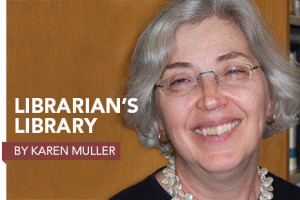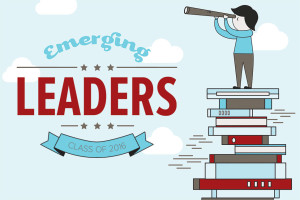
I worry about the future of libraries. I have been a library professional only since 2004, and even then most people who planned to work in a library understood that things were changing. We knew we had to find new, creative ways for libraries to operate and serve communities, or libraries would slowly start dying.
I’m director of Curtis Memorial Library in Brunswick, Maine. As the result of being a worrywart and wanting to make sure that the library makes a successful transition to a technology-driven, digitally dominated future, I spend a great deal of time identifying and evaluating new library programs, processes, and management methods. After years of struggling to find new ideas to drive substantial change, I decided to cast a much wider net. But how do you find and develop such ideas? The first place to look was not at other libraries but other professions.
When I started as a librarian, I looked to business (which was my first career) for ideas that could transfer from one environment to the other. Businesses spend huge sums of money and employ highly intelligent people to run them. Libraries can benefit from their expertise simply by seeking out friendly people in the business world who are willing to share ideas on everything from management styles to alternative programming.
Advocates for the creators
I support libraries being advocates for the arts and collaborators with artists. Libraries are ideally suited to support and mentor local creators such as writers, artists, and musicians, and have a built-in audience with whom to share their works. The challenge is to define how libraries can be creative advocates.
I talked with Margot Atwell, the publishing outreach lead at Kickstarter, the granddaddy of crowdfunding organizations that was established specifically to fund creative projects. Since its launch in 2009, more than 10 million people have pledged $2.1 billion, funding 98,285 creative projects. Kickstarter was of interest to me because as a business its entire reason for being is to support creative endeavors. My hope was to identify from the company’s perspective new ways that libraries might do more to assist and promote creators at the local community level.
Margot came out of the publishing world, is a library lover, and is a very creative thinker. I loved talking to her. Even though she started her career in a very traditional industry, she is open to new ideas and ways of thinking. She was the perfect person to talk with about what libraries can learn from the rest of the world.
Interview insights
Passion was a word that came up over and over in my discussion with Margot. Kickstarter has been extraordinarily successful in finding supporters for thousands of projects, partially because it does everything possible to help creators convey their energy and enthusiasm. Libraries must learn to impart their passion for what they do if they want to attract the attention of a broader audience.
Libraries are very good at sharing information, teaching, and educating. Once people walk through the door of a library, they come back because they discover the riches it provides. However, libraries struggle to get people to walk in for the first time. Why? People are intimidated by all of those books and smart people in one place; they still think that a library is simply a warehouse for books where stern librarians shush visitors; or they think that a library provides only books for borrowing and they’d prefer to read on a Kindle.
The common denominator in all of these views is a lack of knowledge about what today’s library really is. When people think this way, it means that either we have not reached those people with the story or we have reached them but the story did not register. My bet is that people hear our story but it is not powerful and emotional enough. Librarians are good at telling their stories in a factual, accurate, and detailed way—we have been trained to be all those things—but if you get us in a conversation about what we do, we suddenly become passionate. What we do matters! We have the passion, but we need to learn how to show it to the world.
Libraries are one of the most vital, active connectors of communities. We need to promote this role. People want and value connections, and they will support organizations that help them make those connections. However, people need to understand how an organization helps them make those connections. At Kickstarter, this is obvious. The role of the library in building connections across the community is less obvious, so the library needs to do more to communicate how it does this.
The likelihood of a community being supportive of the local library will increase if the community knows the library staff on a personal level.
The likelihood of a community being supportive of the local library will increase if the community knows the library staff on a personal level and understands why they care so passionately about the library. Librarians have always taken great pride in providing accurate, detailed, and unbiased information and services. In addition, many are very good at building professional relationships with those who use the library. The more community members get to know librarians as individuals and understand their passion and dedication, the more often they will stand up to support the library when it is time to establish budgets.
Creators at Kickstarter use video and web resources to convey energy and passion for their work and to talk about their stories and who they are as individuals. This makes a real difference to the people who want to fund their projects. If you feel a human connection with someone because you know how that person thinks, what his or her life story is, and how he or she is going to approach his or her work, and that resonates with you, you are much more likely to want to support what that person is doing.
How to do it
Ask all staff members at your library to identify one thing about their jobs that they love and that absolutely makes their day. Then, ask for volunteers to do a two-minute video about it. The only thing they have to do in the video is make sure they convey their enthusiasm. Ask participants to vote and identify the three best videos (meaning the ones that most accurately convey the speakers’ energy and enthusiasm), and then share those videos online with library patrons. If emotional engagement is something that we want to include in our marketing and communications, we need to experiment with this idea and learn what creates a powerful connection with the viewer.
Identify one of the drier, less exciting resources offered by the library and hold a contest to promote that resource. The staffer who can make a video about one boring resource and gets 50 “likes” on Facebook wins. The goal initially is not to get Facebook likes but to get staff engaged with the idea of creating videos that capture attention regardless of topic.
Ask people running programs at your library to promote them using a short video. The people who conduct programs at your library most likely have tremendous energy and passion for their projects. By making a video of the presenter, you provide him or her with an opportunity to talk directly to potential audience members. This is a much more powerful way to build interest in a program than pictures on a flier or words in a newsletter (though these can also be very useful and certainly should not be eliminated from promotional efforts). This idea can be extended to any or all social media channels your library uses.
Share information that makes the public see the library and librarians in a real way. You could share on your site or social media channels a video detailing what happens at the library before the doors open or a behind-the-scenes look at the librarians’ work area or staff room. Do not script these videos; just shoot and share them. The goal is to make your library users feel as though they know the people who work at the library.
Facilitate connections between different groups in the community. The library can do this because it is a trusted resource. At Curtis Library, we developed an online forum called Curtis Creative Spaces for local artists. It is free to use, and our goal is simply to provide them with a larger audience than what they might initially get on their own. Each month we feature a different artist. To increase awareness for the website, we have raffled off small pieces of art by the featured creators. To participate, people only need to visit the website and share their contact information.
Connect people in new ways through the library. Curtis Library never provided connections between creators and the community in the past, yet it was an obvious way that we could support the creation of local content while still working within the library’s traditional footprint. As libraries consider what roles they can take on for their communities, it makes sense to look carefully at how they can continue to be connectors and not be afraid of roles that seem very different from the past. How about providing a meeting room in the library for genealogists to connect with one another or an incubator where people starting small businesses can share ideas and help motivate one another to success? These are different from the library’s traditional role, yet they demonstrate the library’s core service—connecting people.
This is an excerpt from New Routes to Library Success: 100+ Ideas from Outside the Stacks, by Elisabeth Doucett (ALA Editions, 2015).
Read an interview with author Elisabeth Doucett about this book.

 ELISABETH DOUCETT is director of Curtis Memorial Library in Brunswick, Maine. In addition to a master’s degree from the Simmons College School of Library and Information Science, Doucett has an MBA in marketing from the Kellogg School of Management at Northwestern University. She is author of the books Creating Your Library Brand and What They Don’t Teach You in Library School, both published by ALA Editions.
ELISABETH DOUCETT is director of Curtis Memorial Library in Brunswick, Maine. In addition to a master’s degree from the Simmons College School of Library and Information Science, Doucett has an MBA in marketing from the Kellogg School of Management at Northwestern University. She is author of the books Creating Your Library Brand and What They Don’t Teach You in Library School, both published by ALA Editions.
